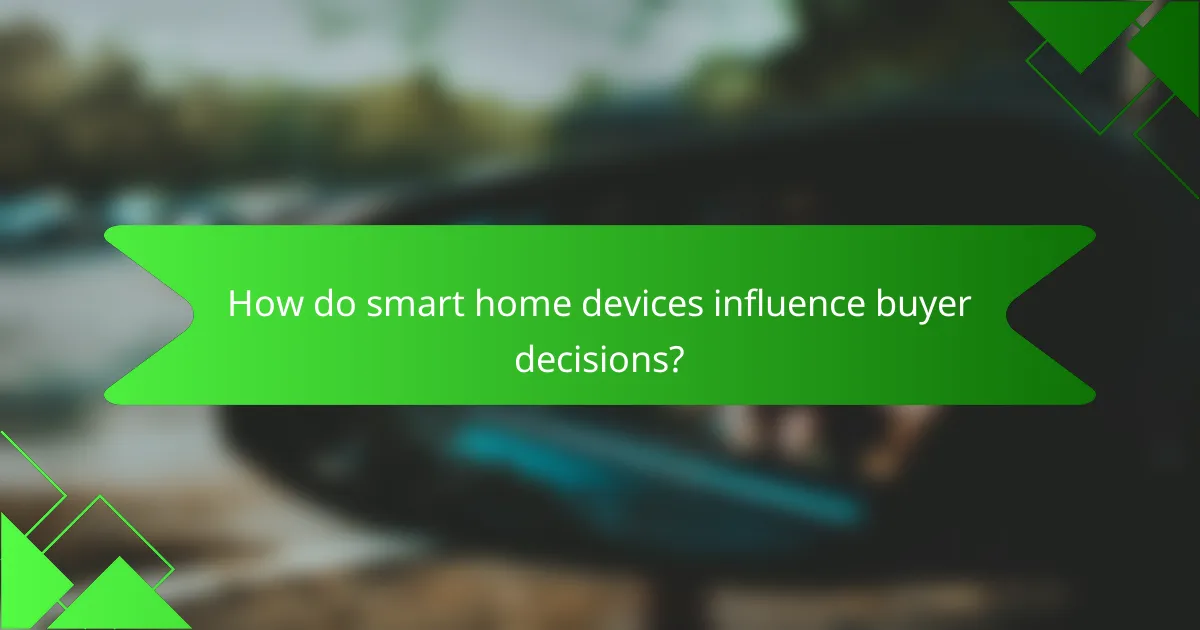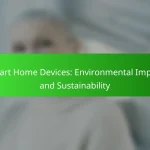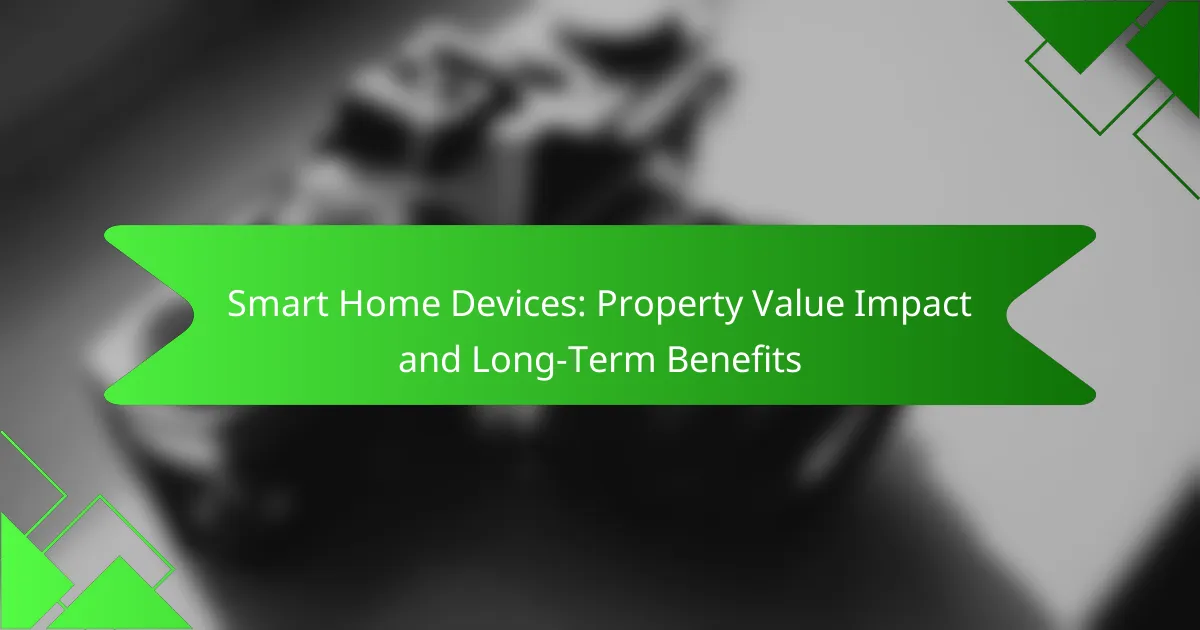Smart home devices are transforming the real estate landscape by significantly enhancing property value, particularly in urban areas. By integrating modern conveniences like smart thermostats, security systems, and lighting solutions, homeowners can attract buyers willing to pay a premium for enhanced functionality and energy efficiency.

How do smart home devices impact property value in urban areas?
Smart home devices can significantly enhance property value in urban areas by making homes more appealing and functional. These technologies often lead to higher resale prices and attract a specific demographic of buyers who prioritize modern conveniences.
Increased resale value
Homes equipped with smart home devices typically see an increase in resale value compared to similar properties without such features. Studies suggest that smart technology can add anywhere from 5% to 15% to a home’s market price, depending on the type and integration of devices.
Investing in popular smart home features, such as smart thermostats, security systems, and lighting, can yield a favorable return when selling. Homeowners should consider the cost of installation versus the potential increase in value when making upgrades.
Attracts tech-savvy buyers
Smart home devices appeal to tech-savvy buyers, particularly millennials and younger generations who prioritize connectivity and automation. These buyers often seek homes that offer modern conveniences, making properties with smart technology more attractive.
Marketing a home with smart features can help it stand out in a competitive urban market. Highlighting the integration of devices like smart speakers, home security cameras, and energy-efficient appliances can capture the interest of potential buyers.
Enhances marketability
The presence of smart home devices enhances a property’s marketability by showcasing its modernity and energy efficiency. Features such as smart lighting and thermostats not only improve convenience but also promote sustainability, which is increasingly important to buyers.
To maximize marketability, homeowners should ensure that smart devices are user-friendly and well-integrated. Providing demonstrations or clear instructions during showings can help potential buyers appreciate the benefits of these technologies.

What are the long-term benefits of smart home devices?
Smart home devices offer several long-term benefits, including energy savings, enhanced security, and increased convenience. These advantages not only improve daily living but can also contribute to the overall value of your property.
Energy efficiency savings
Smart home devices can significantly reduce energy consumption, leading to lower utility bills. For instance, smart thermostats can learn your schedule and adjust heating or cooling accordingly, potentially saving you 10-20% on energy costs annually.
Additionally, smart lighting systems allow you to control lights remotely and set schedules, ensuring lights are only on when needed. Over time, these savings can accumulate, making your investment in smart technology worthwhile.
Improved home security
Smart home devices enhance security through features like remote monitoring, alerts, and automated locks. For example, smart cameras can send real-time notifications to your phone if they detect unusual activity, allowing for immediate action.
Integrating smart locks with your home security system enables you to control access remotely, reducing the risk of unauthorized entry. This added layer of protection can also be appealing to potential buyers, increasing your property’s market value.
Convenience and automation
Smart home devices provide unparalleled convenience by automating daily tasks. Voice-activated assistants can control various devices, allowing you to adjust settings without lifting a finger, which can save time and effort.
Moreover, routines can be programmed to streamline your day, such as having lights dim and the thermostat adjust when you arrive home. This level of automation not only enhances your lifestyle but can also make your home more attractive to future buyers.

Which smart home devices offer the best return on investment?
Smart home devices that typically provide the best return on investment include smart thermostats, smart security systems, and smart lighting solutions. These devices not only enhance convenience and security but can also lead to energy savings and increased property value.
Smart thermostats
Smart thermostats adjust your home’s temperature automatically based on your schedule and preferences, leading to energy savings. These devices can reduce heating and cooling costs by approximately 10-15%, making them a financially sound investment.
When choosing a smart thermostat, consider compatibility with your HVAC system and features like remote control and learning capabilities. Popular models include the Nest Learning Thermostat and the Ecobee SmartThermostat.
Smart security systems
Smart security systems enhance home safety through features like remote monitoring, motion detection, and alerts. Investing in a comprehensive system can increase your property’s appeal to potential buyers, especially in urban areas where security is a priority.
Look for systems that integrate with other smart devices and offer professional monitoring options. Brands like Ring and Arlo provide a range of solutions, from cameras to complete security packages.
Smart lighting solutions
Smart lighting solutions allow you to control your home’s lighting remotely, set schedules, and create ambiance with ease. These systems can lead to energy savings of around 20-30% compared to traditional lighting, making them an attractive option for homeowners.
Consider features such as compatibility with voice assistants and the ability to customize lighting scenes. Popular options include Philips Hue and LIFX, which offer a variety of smart bulbs and fixtures.

How do smart home devices influence buyer decisions?
Smart home devices significantly impact buyer decisions by enhancing convenience, security, and energy efficiency. Potential buyers often prioritize homes equipped with these technologies, viewing them as modern and desirable investments.
Desire for modern amenities
Homebuyers increasingly seek modern amenities, and smart home devices fit this trend perfectly. Features like smart thermostats, automated lighting, and voice-controlled assistants appeal to those looking for a contemporary lifestyle.
Investing in smart home technology can make a property stand out in a competitive market. Homes with these features often attract higher offers, as buyers perceive them as more valuable and convenient.
Perceived safety and control
Smart home devices enhance perceived safety and control, which are critical factors for many buyers. Security systems that include smart cameras, motion detectors, and smart locks provide homeowners with peace of mind.
These devices allow users to monitor their homes remotely, receive alerts, and manage security settings from their smartphones. This level of control can be a decisive factor for buyers concerned about safety.
Integration with existing technology
Buyers appreciate smart home devices that seamlessly integrate with their existing technology. Compatibility with smartphones, tablets, and other smart devices enhances user experience and makes the transition easier.
For example, homes that support popular ecosystems like Google Home or Amazon Alexa can appeal to tech-savvy buyers. Ensuring that smart devices can work together efficiently can significantly increase a property’s attractiveness.

What are the prerequisites for installing smart home devices?
To successfully install smart home devices, you need a reliable internet connection, compatibility with your existing systems, and a basic understanding of user interfaces. These prerequisites ensure that your devices function effectively and integrate seamlessly into your home environment.
Reliable internet connection
A stable and fast internet connection is essential for smart home devices to operate efficiently. Most devices require a broadband connection with speeds typically ranging from 10 to 25 Mbps for optimal performance. Consider upgrading your internet plan if you experience lag or connectivity issues.
Additionally, ensure that your Wi-Fi network covers the entire area where you plan to install devices. Using Wi-Fi extenders or mesh networks can help eliminate dead zones and improve connectivity throughout your home.
Compatibility with existing systems
Before purchasing smart home devices, check their compatibility with your current systems and platforms. Many devices work with popular ecosystems like Google Home, Amazon Alexa, or Apple HomeKit, but not all devices are universally compatible. Researching compatibility can save you from potential integration headaches.
Consider creating a list of your existing devices and systems, such as security cameras, thermostats, or lighting controls, to ensure new devices will work together. This can help you avoid purchasing devices that may not function well with your current setup.
Understanding of user interfaces
Familiarity with the user interfaces of smart home devices is crucial for effective usage. Most devices come with mobile apps or web interfaces that allow you to control and customize settings. Take time to explore these interfaces and understand their functionalities before installation.
Additionally, consider the learning curve associated with different devices. Some may have intuitive interfaces, while others might require more time to master. Reading user reviews and guides can provide insights into the ease of use for each device you consider.

How do smart home devices compare in different regions?
Smart home devices vary significantly across regions due to differences in technology adoption, infrastructure, and consumer preferences. In North America and Europe, for example, smart home technology is widely embraced, while in parts of Asia, the market is rapidly growing but still developing.
North America
In North America, smart home devices are prevalent, with many households adopting products like smart thermostats, security systems, and voice assistants. The market is driven by a strong emphasis on convenience and energy efficiency, with consumers often looking for devices that integrate seamlessly with existing home systems.
Homeowners can expect to see a return on investment through energy savings and increased property value. Popular brands like Amazon, Google, and Apple dominate the market, offering a range of products that cater to various budgets.
Europe
Europe exhibits a diverse landscape for smart home devices, with countries like Germany and the UK leading in adoption. Regulations regarding data privacy and energy efficiency standards influence consumer choices and product offerings. Many European consumers prioritize sustainability, prompting a rise in eco-friendly smart devices.
Integration with renewable energy sources, such as solar panels, is common, enhancing the appeal of smart home technology. Homeowners can benefit from government incentives aimed at promoting energy-efficient upgrades.
Asia
In Asia, the smart home market is expanding rapidly, particularly in countries like China and Japan. High smartphone penetration and urbanization drive the adoption of smart devices, with consumers increasingly seeking automation and connectivity.
However, the market is fragmented, with varying levels of technology acceptance and infrastructure readiness. Local brands often compete with international companies, offering tailored solutions that meet regional needs and preferences.
Australia
Australia’s smart home market is growing steadily, with a focus on security and energy management. Consumers are drawn to devices that enhance safety and reduce utility costs. The market is characterized by a mix of local and international brands, providing a variety of options for homeowners.
Government initiatives promoting energy efficiency also play a role in encouraging smart home adoption. Homeowners should consider compatibility with existing systems when selecting devices to ensure seamless integration.










